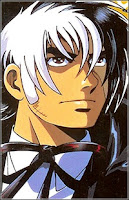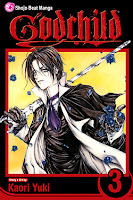Support manga, support your library!
Here’s what I’ve been reading:
 Akira, Volumes 1-2 by Katsuhiro Otomo. Several years ago I watched the anime of Akira and enjoyed it. I think I like the manga it’s based on even better. I find it to be a marvelous, page-turning, science fiction romp. And because it’s an entire series, Otomo is able to explore aspects of the story that he wasn’t able to include in the two hour film; I feel like I can connect with the characters more and understand them and their actions better. There’s plenty of action and violence with all of the delinquent youths, bike gangs, military forces, and resistance organizations, but the manga also has a fair amount of humor to it too that prevents things from getting too dark.
Akira, Volumes 1-2 by Katsuhiro Otomo. Several years ago I watched the anime of Akira and enjoyed it. I think I like the manga it’s based on even better. I find it to be a marvelous, page-turning, science fiction romp. And because it’s an entire series, Otomo is able to explore aspects of the story that he wasn’t able to include in the two hour film; I feel like I can connect with the characters more and understand them and their actions better. There’s plenty of action and violence with all of the delinquent youths, bike gangs, military forces, and resistance organizations, but the manga also has a fair amount of humor to it too that prevents things from getting too dark.
 Banana Fish, Volumes 18-19 by Akimi Yoshida. I had a feeling that things weren’t going to turn out well, but damn this is still heartbreaking. The ending is appropriate and the two side stories included in the final volume were a very nice touch. Yoshida ties up everything by the end, sometimes in surprising ways, but the result is very satisfying. The relationships, good and bad, are what this manga is all about and they are intense. Ash is an extremely charismatic character who profoundly affects those around him. Although the plot developments felt a bit repetitive at times, overall Banana Fish is a great series and I’m really glad that I read it.
Banana Fish, Volumes 18-19 by Akimi Yoshida. I had a feeling that things weren’t going to turn out well, but damn this is still heartbreaking. The ending is appropriate and the two side stories included in the final volume were a very nice touch. Yoshida ties up everything by the end, sometimes in surprising ways, but the result is very satisfying. The relationships, good and bad, are what this manga is all about and they are intense. Ash is an extremely charismatic character who profoundly affects those around him. Although the plot developments felt a bit repetitive at times, overall Banana Fish is a great series and I’m really glad that I read it.
 Godchild, Volume 6-8 by Kaori Yuki. I think that these last three volumes of this manga are also the best in the series. The plot has gotten very dark, and very cruel, but things are starting to make some sense and are pulled together nicely by the end. Cain’s father and his family history are more thoroughly explained although I still don’t understand everything that’s going on. There are some characters that seem to be introduced out of nowhere to force the plot along, and there are still some developments that I’m not entirely convinced by, but for the most part I liked how things ended and how references to earlier volumes were incorporated.
Godchild, Volume 6-8 by Kaori Yuki. I think that these last three volumes of this manga are also the best in the series. The plot has gotten very dark, and very cruel, but things are starting to make some sense and are pulled together nicely by the end. Cain’s father and his family history are more thoroughly explained although I still don’t understand everything that’s going on. There are some characters that seem to be introduced out of nowhere to force the plot along, and there are still some developments that I’m not entirely convinced by, but for the most part I liked how things ended and how references to earlier volumes were incorporated.
 Hana-Kimi: For You in Full Blossom, Volumes 20-23 by Hisaya Nakajo. While I am satisfied for the most part with the ending of Hana-Kimi, the series is definitely a fantasy and not at all how things would have really turned out. The manga seemed to go on a bit too long with a bit too much filler, and the climax was a bit anti-climatic, but it did make me happy to some extent in the long run. However, I will be the first to admit that how Ashiya is finally discovered and outed to be posing as a guy at an all boys school is really, really stupid. I don’t need to read the series again, and a lot of things frustrated me about the manga, but it was kinda fun while it lasted.
Hana-Kimi: For You in Full Blossom, Volumes 20-23 by Hisaya Nakajo. While I am satisfied for the most part with the ending of Hana-Kimi, the series is definitely a fantasy and not at all how things would have really turned out. The manga seemed to go on a bit too long with a bit too much filler, and the climax was a bit anti-climatic, but it did make me happy to some extent in the long run. However, I will be the first to admit that how Ashiya is finally discovered and outed to be posing as a guy at an all boys school is really, really stupid. I don’t need to read the series again, and a lot of things frustrated me about the manga, but it was kinda fun while it lasted.












